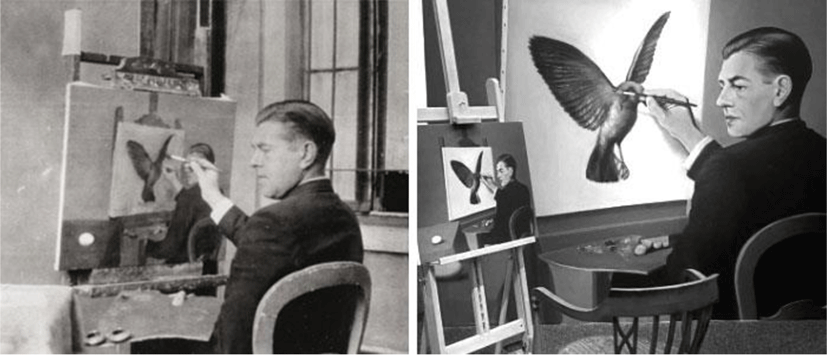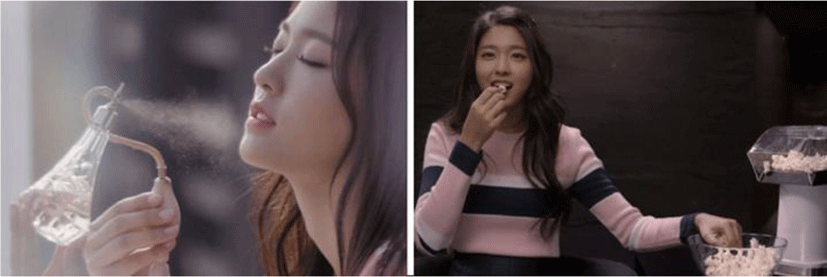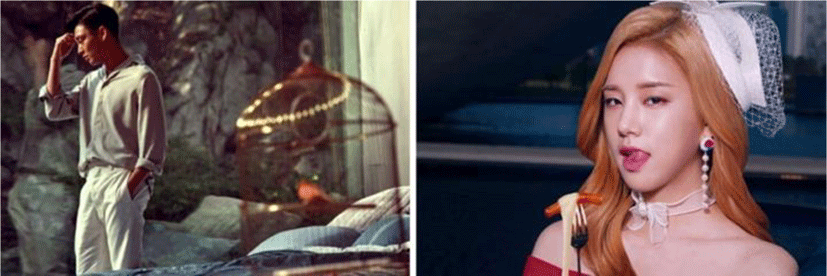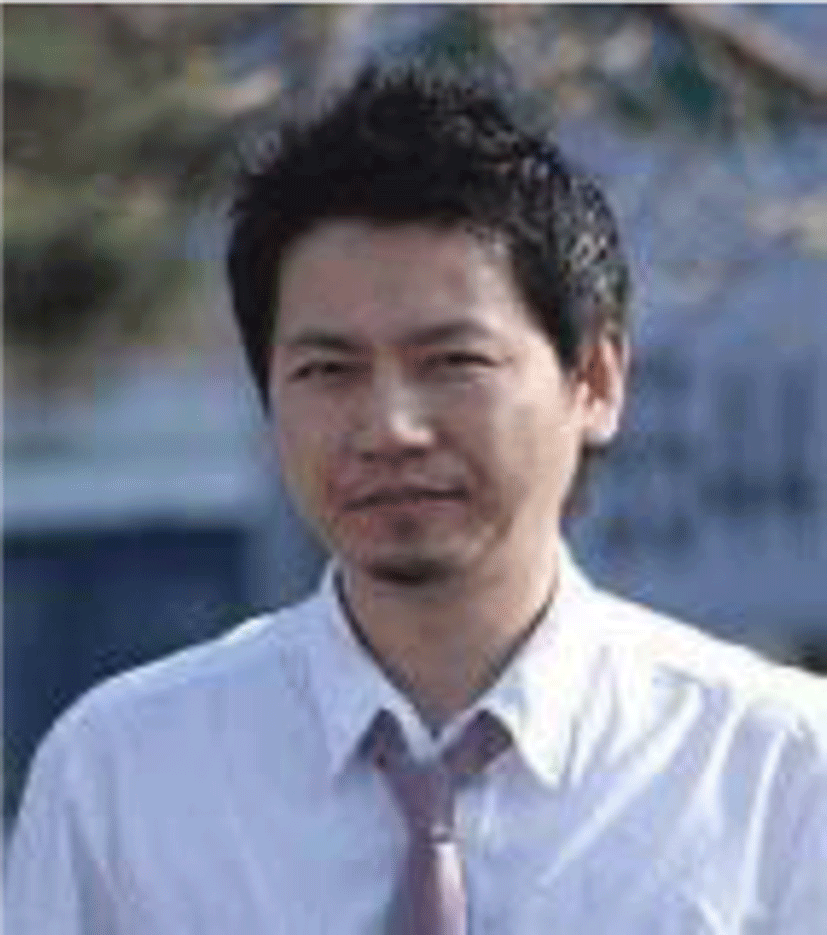I. INTRODUCTION
Images are very close to us, and images using media are familiar in our lives, whether static or dynamic. These images range from pictures to photographic images, with slight differences in the tools of the medium. In order to study the images in which static and dynamic images coexist in these media, the featured elements are compared. The analysis focuses on a mix of elements including time, duality, difference, and falsehood that occur in the mixed elements among the features of pictures, pictures, and images. These images are expected to increasingly evolve and offer value and purpose to the research. Based on the characteristics of the current image introduced in Korea, we will; clarify it through the CF case and analyze it based on each keyword. In addition, while image research continues, newly converged content is based on the application of existing ones.
II. IMAGES AND CINEMAGRAPHS
The relationship between the subject and the object that has historically progressed from painting to photography and video has changed over time and has culturally shifted. Seeing an object from a spatial distance differs from touching the object by hand. Descartes once stated that vision is the most common and noble of the senses[1]. Therefore, vision or ‘sight’ constructs meaning insofar as it recognizes everything from a specific perspective; vision is both intuitive and analytical and permits the viewer to gather essential information and determine its importance.
With the advent of the nineteenth century, conventional customary images have been improved to optical images due to the invention of photography. Photographs are traces of light from an object, meaning a state in which the still image of the moment in which the phenomenon of the object exists is still locked. Therefore, the existing object is replaced by the image. The image is characterized by the non-materiality of the object itself. It is made of light, and the image corresponding to the rational space indicates the object through sight. In customary images such as paintings, images were further developed into photographs. Photographs were comprised of fragments, frame-by-frame, gathered by light, which made the motion due to the 1/24 frame, which was expressed as an image. Since digital images are made of mechanical images, it is possible to understand the process of making digital images produced by a binary of 0 and 1.
After discussing the image, it is essential to consider the environment in which images exist—namely, traditional media and new media, the latter of which will be explored, As traditional media evolved into new media the relationship between the two sets of images, pertaining to each type of media, has changed. Cinemagraphs existing between photographs and images can be said to complement the limitations that can be expressed as photographs and to control the spectacle parts overflowing with images.
III. Analysis of Time, Duality, Difference, and Virtual image
We analyzed the characteristics that categorized each feature from image to painting, photography, video and digital convergence image, based on the keywords “time”, “duality”, “difference”, and “virtual” Content that is characterized by duality led to an overlap of photographs and images. These were selected first; since the overlap between photographs and painted images indicates a strong connection between their characteristics, despite the temporal gap that exists in terms of when and how they were produced. The keywords are connected and mixed together until they become unfamiliar cinemagraphs felt by users and viewers due to fictional images that can create unrealistic surprises and differences between them.
Furthermore, images can be analyzed using semiotics. The renowned linguist, Ferdinand de Saussure (1857–1913), viewed semantic structure as the fundamental basis of the first stage semiotics. Semiotics has a binary opposition, meaning that two components or elements combine to create a symbol. Symbolic representation has physical properties which are represented by words or images. The physical reality(object) is known as the ‘signifier’, while the mental concept or meaning attached to the object—usually in the form of a word or an image—is called the sign[2].
The concept of time is a term that refers to the unit of time between time. Time has units, where 1 minute is equal to 60 seconds, and 1 hour is equal to 60 minutes. The concept of repeated time keeps flowing, always moving and telling the existence of natural phenomena.
The temporal meaning needs to analyze time-related philosophical meanings such as Husserl Edmund's (1859~1938) and Heidegger's (1889~1976) phenomenology. Heidegger's definitions of time is important, in a philosophical sense, as he discusses the idea of temporality in relation to the German word “Dasein” which translates into “There-being” in English. Being is in the fundamental sense of “I am” [3]. People express it as time passes or flows. “The flow of water that I pass by now exists in front of me now and heads to the sea where I have flowed,” says the story of time. If time moves in a river-like flow, then it flows like water from past to present, present to future. The present is the result of the past, the future is the result of the present. Thus, time functions as a continuum. Time is present in the flow but can be differentiated according to each and evey second, due to the flow of the moment. Time belongs to an existential relationship. Maurice Merleau Ponty (1908~1961) is said to exist as long as the past, present and future are not in the same sense [4]. Cinemagraph images are also seen as a dual world due to the different overlaps. The time of the event of the image has the same synchrony as it is in the same place, but it will be one of the characteristics of the cinemagraph in the temporal relationship as the two past futures are combined or the past present are combined to feel the duality of time. Two elements of photography and video mediate the same movement as the phenomenon.
Duality is understood to be a combination of two concepts combined into one or overlapped. In effect, a ‘cinemagraph’ requires the coexistence of both pictures and videos. If there is only a single static or dynamic image of a photo, it is not a cinemagraph; the two elements must inevitably exist as features in the image of the cinemagraph.
Sigmund Freud (1856~1939) once stated that no man is his own owner. One's own master is the reality of consciousness and unconsciousness becoming one. It is an integrated self. Before becoming an integrated self, humans live with a divisive self. Man may or may not become his own subject as much as he has become consciously self-consciously unconscious [5].
Pataphysics, advocated by the French writer Alfred Jarry (1873~1907), insists on the revival of 'poetic imagination' with criticism while being revulsied by modern scientific thinking that reveals the limits of reason. Patafos do not separate but overlap. The ontological overlap between virtual and reality is called pataphysics. Pataphysics parodied metaphysics, which means philosophy, but it means that reality and metaphor overlap in our daily lives as well as in art [6]. The digital world is misleading because it is a world where virtual reality and augmented reality overlap. Cinemagraph images are characteristic of double overlapping images as they represent this modern society.
Gilles Deleuze (1925~1995), a philosopher of difference and was renowned for his concepts of difference and repetition. He was heavily influenced by Henri Bergson's (1859~1941) idea of "Matiere et memoire" and the concept of difference in Deleuzean philosophy. Matter, like objects, is visible, but minds, like thought and memory, are invisible and untouchable. Thus, material and mind appear to be totally different in nature. The question the relationship between material and spirit is important and Bergson's philosophy necessitates further research on the subject. The material things we see have their meanings and concepts. But if there is no friend present when we look for them in an empty room, we say, "Nobody." The meaning of “empty” is that we are consciously remembering only what we want to see while excluding things that we ignore. Matter and spirit are seen as opposing realities, creating continuity by making repetitive consciousness and difference between perceiving and perceiving as multiplicite qualitative [7]. Perception involves the work that occurs between the images in order to connect them and is integral to the dynamic motion that characterizes the process of ‘giving and receiving’ that is involved in the reception of images; it has the persistence of constantly repeating perceived differences, repeating them as potential movements. All phenomena are represented by the time flow of difference and repetition. Deleuze suggests that the concept of repetition is not a representation of ‘the same’, but it is the power of repetition that makes a difference. Over the passage of time exact duplication is difficult, if not impossible, which fundamentally challenges the very idea of repetition. Over time, it's similar to the previous one, but because it makes a difference, it becomes a comparison. Comparisons between two different objects lead to better choices, and differences and repetitions develop cyclically. The creation of difference in the cinemagraph is a new form that is distinguished from the original (photo) and the other (video) in the difference of Gilles Deleuze to create a new and different from the original. These distinct differences create new things that are neither photographs nor images. As such, the generation of the difference has a world image of the Between that we do not see.
The virtual or fictional image of a cinemagraph appears in the difference in time as in the relationship between the virtual image and the actual image. In the cinemagraphs, the mirror image is a phenomenon in which the copied image reflected in the mirror and the actual image move differently or are not understood in the scientific and logical world. In addition, the moving scene from the viewpoint of photography also has the meaning that the photograph is a fictional image as a result of having no movement.
The work of Rene Magritte (1898~1967) reveals the doubts we may have about what we see and how we see it. The critical perception of the habitual perception that sees it is not everything but the fictional image that is mixed, and it is recognized through the deception of the eye. In Magritt's “Insight (1936)” the egg on the table passes through the artist's eyes and hands, and the canvas is painted with the bird's image, but not the bird's egg. The heterogeneous and unfamiliar understanding of the painting is expressed in the same moment in time from the beginning of the egg to the bird, making viewers experience an illogical relationship, so that it feels as if the world where the present and the future of the egg coexist.
Cinemagraphs move in manner similar to the surreal that Magritte sought. Or it feels like a virtual world that the images that are not moving are in the same being.
IV. Cinemagraph Example with Four Keywords
Gmarket's model used a partially moving cinemagraph to highlight the merchandise of a shopping mall. In semiotic analysis, the sign conveyed by partial movement means the movement of the product itself, but it conveys the buyer's drama and stimulates the psychology of the advertisement, which shows the meaning of impulsive consumerism.
Advertisement generally attempts to effectively depict messages using cinemagraph techniques and to give the sender memory and attention to focus or give meaning to the message. So you can see the case of advertisement by using the method of cinemagraph to make the image differently or emphasizing. We will discuss the four keywords of the cinemagraph techniques used here.
The cinemagraph of the Gmarket Ad makes the partial element visually visible by moving the part that emphasizes the product that the consumer wants. The desired product is introduced as a recommended product according to its category, and only the product moves in an artificial still image, and the consumer remembers the ironic situation. Time doubles the still picture of the scene where the image is currently moving and the video continuously flows, and seeks strangeness. This scene always seeks a dual image, and the cinemagraph always takes the form of a dual image and is not a common image. So is it a photograph in the form of a neutral medium? Is it a video? Consumers are confused. The section of the cross section and the repeated motion continuously repeat only the unknown behavior where the beginning or end ends. Ongoing movements want consumers to read the message that they want to emphasize or say. So in what way is a photograph and a video image like a fictional imaginary image? The unfamiliar pursuit of unfamiliarity stimulates consumer sentiment, which can be seen as using cinemagraphs as a product advertisement.
SesaLiving seems to look at an image picture book that expresses a fairy tale world in static space. It is a psychological stimulus given by accidentally discovered stimulus in an image with almost no movement through symbolic interpretation, and it is interpreted as a miraculous image in which the recipient expands the imagination.
The sesaliving advertisement is characterized by stimulating the emotions flowing statically using the cinemagraph technique in which some movements appear, as if to find a treasure in a still picture. Gmarket advertising is a bright impression and cute elements, sesaliving advertising is an advertising that makes you find a serious, quiet and fun movement in the image. So we use camera viewpoints to discover some of the movements in memory as we explore and explore memory in time. So he recalls past memories or explores the images of the past, and pays attention to the product characteristics of the advertising model according to his actions. Overlapping stimulates aesthetic emotions in visual arts that seem to think for a while with storytelling of memory, thus stimulating emotions and delivering mysterious images. The most distinguishing feature is that there have been no advertisements for daily life, and static still images for expressing something make you feel good or make you think. Like the fairy tale world, scary sensibility and strange elements make you scared. Therefore, he creates a fictional image naturally with the technique of cinemagraph.
Sinjeon Stir-fried Rice Cake is to match the product with the taste that stimulates the cute and sexy of the woman to show the hot taste and the youthful and youthfulness together. The appearance may be a commodity, but the meaning of the meaning is represented by a stimulating taste.
Sinjeon Stir-fried Rice Cake has a very stimulating, youthful taste. The use of a youthful idol girl group, permitted the advertiser to utilize novel, puppet-like movements, similar a puppet show. Cinemagraph technique is an example of the use of movement in the absence of life-like vitality. The cinemagraph emulates changes in a play and the way in which time is organized in a play. Scenes that appear to be ‘broken’ with disparate gestures are gathered together to form a video. In the overlapped form, repeated elements of intervals of constant time difference, appear continuously. Therefore, repeated elements are produced from beginning-to-end, like paper dolls or model dolls. The discriminated contents are rather awkward because of the unnatural connection disconnected from the images due to the movement of the doll, but the artificially displayed scenes are distinguished from the general images. Thus, continuous time and movement lead to frame-by-frame movements to maximize the effect. The photographs represent the fragmentary, one-dimensional movement of puppetry as if the character image or the still picture is moving, and the new scene creates a different scene from the human-made doll model. As a whole, it is a video image that expresses the characteristics of the characters, together with the cinemagraph technique by artificially directing them as if they are cute and beautiful girls. It is an interesting image that appeals to the product by integrating it with the product, and it also stimulates interest.
V. CONCLUSION
Cinemagraph's images can be found by analyzing the changing process of images and enumerating the features according to modern digital convergence images. Among them, keywords were derived and derived into four characteristics: features of time, duality, difference, and virtual. The features found in the images that were created according to it made a distinctive image because Cinemagraph was newly born as a neutral or fused medium. Images were drawn at the primary level and sought passive material dissimilarity before cloning techniques emerged.
As technology progressed, photographs appeared, the technology of cloning developed, and multiple sheets came together to make an image. Video is an image of the world that we see with our eyes. It has a continuous continuity. Cinemagraph is an overlapping image of a static picture and a dynamic picture here. Therefore, digital technology has been utilized in various media. Cinemagraph images viewed as keywords in this study stimulate the subjective psychology that we feel and are used as advertisements or device contents.




